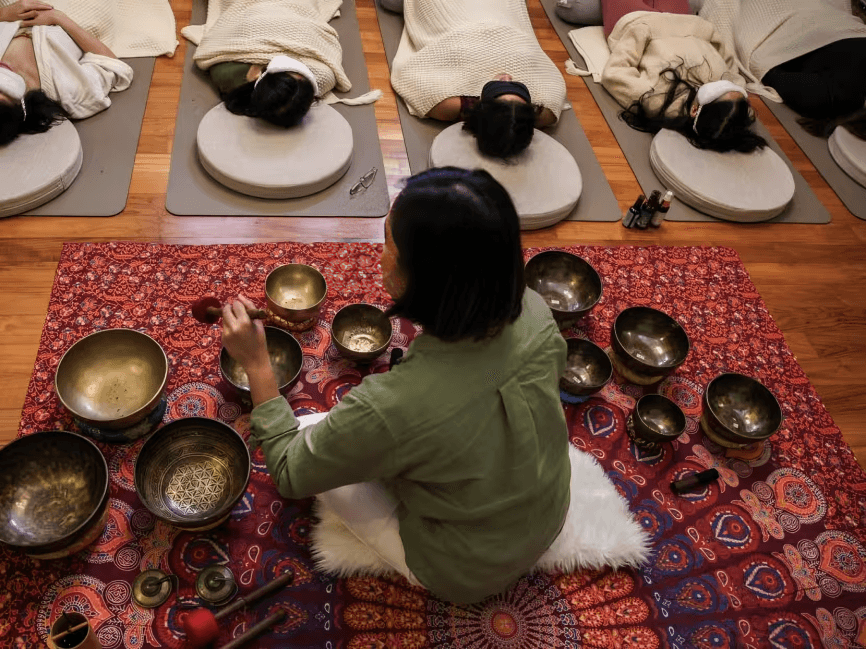
“
Sound healing and vibrational therapy are holistic practices that utilize sound frequencies and vibrations to promote physical, emotional, and spiritual well-being. These therapies have been employed for centuries across various cultures, aiming to restore balance and harmony within the body. 1
1
1
”
Ancient philosopher Pythagoras believed that sound vibrations could heal the body and soul. He developed harmonic theories, suggesting music and vibrations could align inner energies, much like a tuning instrument. 1
Sound healing uses specific tones from gongs, chimes, bowls, or tuning forks that interact with the body’s energy fields, helping to restore balance and harmony in the nervous system. 2

Sound vibrations can penetrate the body at a cellular level, helping realign imbalanced cells by influencing their natural oscillation patterns, thus supporting the body’s ability to heal itself naturally.
Vibrational therapy is known to support better sleep quality by regulating brain waves, relaxing muscle tension, and reducing nighttime overthinking that often contributes to insomnia and poor rest. 3
Instruments like Tibetan singing bowls produce rich harmonic tones that are believed to stimulate alpha brainwaves, which can foster creativity, reduce anxiety, and improve mood and emotional regulation. 4
Chanting mantras or vocal toning during a healing session encourages rhythmic breathing, balances heart rate, and aligns voice with body energy, resulting in emotional grounding and spiritual clarity. 5
Sound baths immerse the listener in a flow of resonant tones that envelop the senses, promoting deep stillness, calming internal chatter, and creating space for personal reflection and release. 6
Vibrational therapy may stimulate the vagus nerve, which connects the brain to several vital organs, enhancing emotional stability, lowering inflammation, and boosting immunity through calming neural signals. 7
Consistent sound healing sessions can elevate mood by increasing serotonin and dopamine, two neurotransmitters that support joy, motivation, and a more positive outlook on daily experiences. 8

Binaural beats work by playing slightly different tones in each ear, prompting the brain to synchronize with the difference in frequency, which helps induce meditative states and deep relaxation.
Rhythmic drumming patterns are often used in vibrational therapies to synchronize brainwave activity, encouraging focused attention and spiritual or emotional breakthroughs in individuals. 9
Some practitioners use specific musical intervals to target and clear blocked energy pathways in the body, which may help ease discomfort and promote clearer thinking and energy flow. 10
Therapeutic sound can enhance heart coherence by helping synchronize heart rhythms and breathing patterns, which leads to better emotional regulation and increased physical and emotional resilience. 11
Playing soft, harmonic sounds during or after physical injury may help reduce perception of pain, regulate the stress response, and encourage calm states necessary for faster healing and rest. 12
Vibrational therapy works with chakras—energy centers in the body—by directing sound frequencies that match each center’s vibration, aiming to restore balance and support emotional and spiritual well-being. 13

People undergoing sound therapy often report tingling sensations or lightness in their body, signs that stagnant energy is moving and the nervous system is entering a deeply restorative state.
Sound healing can aid in releasing emotional trauma by stimulating areas of the brain associated with memory and emotion, offering a gentle path for confronting and processing past pain. 14
Exposure to vibrational frequencies can promote immune health by reducing chronic stress and encouraging biochemical balance, making it easier for the body to resist illnesses and inflammation. 15
Group sound healing sessions build a sense of community, as shared frequencies create collective resonance that can amplify feelings of connection, comfort, and emotional safety among participants. 16
Persian physician Avicenna documented how melodies and rhythms influence the soul and body, suggesting that music, when used wisely, could calm distress and heal both mental and physical ailments. 17


